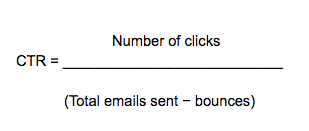The click-through rate, or CTR, is one of the most important email marketing benchmarks; let’s talk about what it is, how to calculate CTR, and of course, how to improve email CTR and open rate.
But first, did you know the Keap app comes preloaded with an extensive library of flexible, functional email templates for a variety of opportunities? Check out how Keap can help you create powerful email communications.
What is click-through rate?
Click-through rate measures how many times recipients click a link in your email, and it is the main marker of audience engagement. The higher your click-through rate, the more things are going well for your emails; it means that you’re not only getting great inbox placement, but also that your content is engaging and relevant, so people are clicking.
The click-through rate formula
Calculating click-through rate isn’t too hard, but there is one thing you must decide before you ever begin your CTR calculations, and that is, how are you going to define a click?
You can measure one click in two ways:
- Clicks by an individual person
- Individual clicks
In the first scenario, if an individual person clicks the same email link three times, it would count as one click. In the second scenario, if an individual person clicks the same email link three times, it counts as three clicks.
Check out Keap's Lifecycle Automation Assessment to determine where your business stands among the industry's top performers.
If your definition of a click waffles every time you calculate CTR, your numbers will always be inconsistent. Pick a way you measure a click, and stick to it with a click-through rate calculator.
Now we can get to the click-through rate formula. Here it is:
CTR is the number of clicks divided by total emails sent minus bounces. So, if you sent 1,000 emails, got 34 bounces, and had a total of 32 clicks, your equation would look like this:

And your click-through rate would be 3.31 percent, a perfectly respectable click-through rate.
What is a good click-through rate?
If you’re feeling disheartened because your CTR seems low—like, really low—chances are you don’t need to feel too down: a “high” CTR is more than four percent. In fact, an IBM study shows that CTRs top out globally around 9.5 percent! It also depends on your country—open rates tend to be higher in Australia and New Zealand (5.1 percent) and lowest in the Middle East and North Africa (1.9 percent average).
According to the same IBM study, the industries with the highest click-through rates (between 4 and 5 percent) are computer hardware and telecommunications; non-profits, associations, and government; and schools and education. Those with the lowest rates (between 2.4 and 2.7 percent) are lodging and travel services; media and publishing; and computer software and online services.
That’s right: if your click-through rate average is around two or three percent, you’re doing just fine. In fact, you’re right in line with average click-through rates. But you should always aim high—shooting for between four and five percent is an excellent click-through rate benchmark.
How can I increase my click-through rate?
Improving your CTR is not a straightforward process—there are a number of factors at play, but there are a number of things you can do to find out what works and what could be improved.
First, you can finesse your email subject lines. If you get more people opening your emails, you’ll get more people who might click your links. A/B testing your subject lines will help you figure out what your audience most responds to.
You should also A/B test your content. Do your subscribers like long newsletters filled with content, or do they like concise emails without the frills? Do they like a personal note from a person at your business, or do they prefer a more generalized newsletter? Don’t assume you know the answer—test it! Chances are, you’ll get at least one surprise.
Also, keep track of the kinds of things that people click on. Do they respond to company news, sales, blog posts, videos, or announcements? Look at what kinds of offers they like, whether it’s new products or discounts on existing ones. Maybe they like advice about certain kinds of problems, or tips on what to eat or wear. Tracking content trends over time will help you provide better links they will want to click on.
Finally, once you’ve fussed with subject lines and copy, you can start testing things like buttons and calls-to-action. You can mess with button color and copy, placement, or even images. Little tests like those mentioned are great ways to find quick wins. There are infinite factors to test and adjust to keep that click-through rate climbing.
The best way to keep that CTR stellar is to calculate it consistently and pay attention to the results. It’s a simple formula that can help you make your email marketing more effective by providing value to your recipients, which will make your emails more valuable to you.




